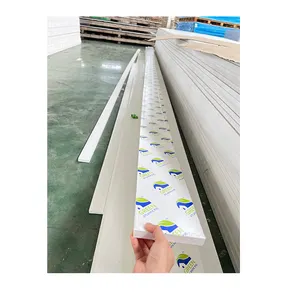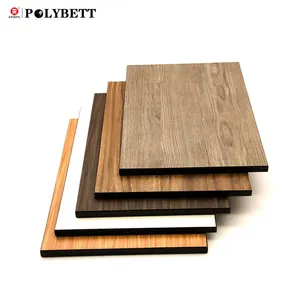
19mm 25mm 3/4'' White PVC Trim Board PVC Profiles For Door And Windows 89mm 114mm 235mm Customized Width


CZBULU Factory Direct Supply A1 Fireproof Grade Mgo Board Magnesium Oxide Board For Wall Partition Ceiling























Welcome to a comprehensive guide that explores the transformative power of laminated composite board in interior design. This material, which has evolved from its initial use in electrical applications, has become a versatile and popular choice in interior design. This article delves into the history, benefits, and features of laminated composite board, demonstrating how it is revolutionizing the world of interior design. We will explore its versatility, sustainability, durability, and cost-effectiveness, and provide practical tips on how to implement, choose, and maintain laminated composite board in your design projects.
Laminated Composite Board, invented in the early 20th century, is a laminated composite material initially used to replace mica in electrical applications. It's now produced globally by various manufacturers. The product is a heat-resistant, wipe-clean laminate of paper with melamine resin. It's known for its versatility in various applications, making it a popular choice in interior design and other industries.
Laminated Composite Board has a rich history of discovery and innovation. Initially, all laminates were made from the mineral mica, but innovators discovered a more economical alternative, leading to the creation of laminates that were strong, light, and excellent electrical insulators. This innovation revolutionized laminate production.
Laminated Composite Board is gaining favor for its durability and reliability, especially in kitchen countertops. It's more attractive than before, blending into most kitchens effortlessly. Cleaning is simple, requiring just a wet paper towel and dish soap. It's resistant to scratches, dings, cuts, and scuffs, outperforming granite and other countertop materials. Additionally, it is cost-effective, offering a low-cost yet high-value solution for kitchen renovations.
Laminated Composite Board, a type of decorative laminate, is revolutionizing interior design. It's used as a surface for furniture and walls, transforming ordinary interiors into extraordinary ones. With this material, you can achieve the look of wood, marble, or stone without the associated cost and maintenance. It's a versatile material, offering limitless design options from solids to textures mimicking natural materials. It is also sustainable, durable, and easy to maintain, making it a practical choice for modern interiors.
The versatility of Laminated Composite Board is showcased in the latest collections, which introduce a variety of new designs. These designs range from organic patterns and modern marbles to surfaces mimicking natural materials like wood and metal. This versatility allows Laminated Composite Board to cater to a wide range of design aesthetics, making it a go-to choice for interior design.
Laminated Composite Board countertops are renowned for their durability. They are made by combining kraft paper with layers of thermally fused melamine resin, resulting in a scratch-resistant and heat-resistant material. This makes them an excellent choice for kitchen countertops and other surfaces. Moreover, these boards are sustainable as they are made from paper or fabric, making them an eco-friendly choice. They are also easy to clean, requiring no special cleaners, further enhancing their sustainability.
Laminated Composite Board is a cost-effective option for countertops, often less expensive than granite and other materials like marble. Its composite nature contributes to its affordability, making it a preferred choice for many homeowners. This cost-effectiveness could be a primary reason to opt for this material, regardless of other trends. Therefore, its strengths are well suited to fill the market opening left by other more expensive countertop options.
When implementing Laminated Composite Board in your design, consider the tone of the room first. Laminates, available in a range of colours, can set the foundation for your room. They can be used to create high-end, sophisticated-looking furniture, adding a touch of class to your space. High-pressure laminates can also transform your walls, offering impact, scratch, and moisture resistance. Even your wardrobes can benefit from the grace and style of these laminates. With these tips, you can enhance the appearance of your room using Laminated Composite Board.
Choosing the right Laminated Composite Board depends on your project's needs. Consider the General Purpose Grade for a variety of projects, useful in both horizontal and vertical applications. The Horizontal or Vertical Post-forming Grade is practical and decorative, fitting onto target surfaces with ease. Metallic Laminate, available in various grades, is ideal for vertical applications or as a decorative addition. The Backing Sheet Grade is determined by the amount of interior use the surface will see. Always consider the grade, thickness, and application when selecting your Laminated Composite Board.
Laminated Composite Board is frequently used for kitchen counters and wall decoration. It's easy to clean, relatively durable, and can be cut using ordinary saws, making its installation a great DIY project. However, being plastic, it can melt if exposed to excessive heat. It comes in various styles, offering flexibility in design.
Maintaining and cleaning Laminated Composite Board surfaces can be straightforward. For general stains, a soak with soap water or detergent can be effective. Stubborn stains may require a paste of water and powdered cleanser, or baking soda and soda water, applied and left to dry before removal. For very stubborn stains like coffee or hair dye, acetone nail polish remover can be used with caution. However, always test on a hidden corner first to avoid discoloration. Despite these methods, Laminated Composite Board will naturally discolor with age, and in some cases, replacement may be the best option.
Laminated Composite Board has indeed revolutionized interior design with its versatility, durability, sustainability, and cost-effectiveness. Its wide range of designs and textures, mimicking natural materials like wood and stone, allows it to cater to various design aesthetics. Its durability and easy maintenance make it a practical choice for modern interiors, while its cost-effectiveness makes it a preferred choice for many homeowners. When implementing Laminated Composite Board in your design, consider the room's tone, the right grade for your project, and the appropriate installation techniques. With proper maintenance and cleaning, Laminated Composite Board surfaces can retain their beauty and functionality for years. In conclusion, Laminated Composite Board is a transformative material in interior design, offering limitless possibilities for creating extraordinary interiors.